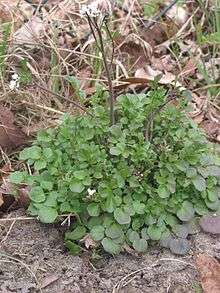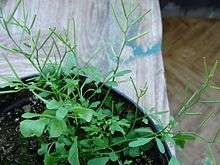Cardamine hirsuta
| Hairy bittercress | |
|---|---|
 | |
| Scientific classification | |
| Kingdom: | Plantae |
| (unranked): | Angiosperms |
| (unranked): | Eudicots |
| (unranked): | Rosids |
| Order: | Brassicales |
| Family: | Brassicaceae |
| Genus: | Cardamine |
| Species: | C. hirsuta |
| Binomial name | |
| Cardamine hirsuta L. | |
| Synonyms[1] | |
| |
Cardamine hirsuta, commonly called hairy bittercress, is an annual or biennial member of the mustard family (Brassicaceae), and is edible[2] as a bitter herb. It is a common weed in moist areas and has been transported to many new regions by humans.
Description

Depending on the climate C. hirsuta may complete two generations in a year, one in the spring and one in the fall; also depending on the climate, the seeds may germinate in the fall and the plants may remain green throughout the winter before flowering in the spring. It often grows a rosette of leaves at the base of the stem, while there may be leaves on the upright stem, most of the leaves will be part of the basal rosette. The leaves in this rosette are pinnately divided into 8-15 leaflets which have short stems connecting them to the petiole. These basal leaves are often 3.5-15 cm long. The leaflets are round to ovate in shape and may have smooth or dentate edges. The leaflet at the tip of the leaf (terminal leaflet) will be larger than the other leaflets and round to reniformly shaped. The cauline (attached to the upright stem) leaves are also pinnately divided, with fewer leaflets, and generally smaller than the basal leaves; these leaves will be borne on a petiole and are 1.2-5.5 cm long. The stems, petioles, and upper surfaces of the cauline leaves are sparsely hairy.
Plants of this species are usually erect and grow to no more than 30 centimetres (12 in) from a stem which is either unbranched or branched near the base.[3][4] The small white flowers are borne in a raceme without any bracts,[4] soon followed by the seeds and often continuing to flower as the first seeds ripen. The flowers have (4) white petals (which may be lacking but are mostly present)[5] which are 1.5-4.5 mm long and spatulate shaped. The flowers also and have (4) stamens of equal height instead of the 6 which are found in most closely related plants. Below the flowers there are 4 sepals which are oblong shaped and 1.5-2.5 mm long and .3-.7 mm wide. The seeds are borne in upright pointing siliquae which are straight and 1.5-2.5 cm long and 1-1.4mm in diameter. When the fruit is ripe the valves on the siliquae will coil tightly from the bottom to the top after being touched and burst explosively, sending the seeds flying far from the parent plant.[6] This seed dispersal strategy is referred to as ballochory and is a type of rapid plant movement.
Hairy bittercress is very similar to Cardamine flexuosa. Some differences are that the stems are hairless and the leaves do not clasp the stems, as in C.flexuosa. It has only 4 stamens, C. flexuosa has 6 stamens, and the fruits overtop the flowers. In C. flexuos the fruits do not overtop the younger flowers. The fruits grow in a thin pod arranged as a single row.[7][8]
Habitat and distribution
Commonly found in damp, recently disturbed soil, open ground, turf and wasteplaces.[6][9]:401 Europe as far east as the Caucasus, and North Africa.[10] These conditions are prevalent in nursery or garden centre plants, and hairy bittercress seeds may be introduced with those plants. Once established, particularly in lawn areas, it is difficult to eradicate. The tiny flowers are attractive to a few early butterflies, including (in the United States) spring azure (Celastrina ladon) and falcate orange-tip (Anthocharis midea).
It is native to Eurasia but has been introduced in many countries across the world. Its range includes but is not limited to: Argentina, Canada, China, Columbia, Costa Rica, Ecuador, Gabon, Great Britain, India, Japan, Laos, Madagascar, Mexico, Pakistan, Panama, Peru, Philippines, South Africa, Sri Lanka, Thailand, Turkmenistan, United States, Venezuela, and Vietnam.[11][4][12]
Names

Other common or country names include lamb's cress, land cress, hoary bitter cress, spring cress, flick weed, and shot weed (or lambscress, landcress, hoary bittercress, springcress, flickweed, and shotweed). Some of these common names may be shared with other plants in the Brassicaceae family and are therefore of limited usefulness since they may be shared. As Old English stune, the plant is cited as one of the herbs invoked in the pagan Anglo-Saxon Nine Herbs Charm, recorded in the 10th century.
References
- ↑ "Tropicos | Name - !Cardamine hirsuta L.". www.tropicos.org. Retrieved 23 June 2016.
- ↑ Dennis Horn; David Duhl; Thomas Ellsworth Hemmerly; Tavia Cathcart (2005). Wildflowers of Tennessee, the Ohio Valley, and the Southern Appalachians: the official field guide of the Tennessee Native Plant Society. Edmonton: Lone Pine Publishers. p. 112. ISBN 978-1-55105-428-5.
- ↑ Clapham, A.R., Tutin, T.G. and Warburg, E.F. 1968. Excursion Flora of the British Isles. Cambridge. University Press. ISBN 0521046564
- 1 2 3 "Taxon Page". www.efloras.org. Retrieved 23 June 2016.
- ↑ "Taxon Page". www.efloras.org. Retrieved 23 June 2016.
- 1 2 Rhoads, Ann; Block, Timothy. The Plants of Pennsylvania (2 ed.). Philadelphia Pa: University of Pennsylvania press. ISBN 978-0-8122-4003-0.
- ↑ Webb, D.A., Parnell, J. and Doogue, D. 1996. Dundalgan Press Ltd. ISBN 0852211317
- ↑ Parnell, J. and Curtis, T. 2012. Webb's An Irish Flora. Cork University Press. ISBN 978-185918-4783
- ↑ Stace, C.A. (2010). New flora of the British isles (Third ed.). Cambridge, U.K.: Cambridge University Press. ISBN 9780521707725.
- ↑ http://linnaeus.nrm.se/flora/di/brassica/carda/cardhirv.jpg
- ↑ "Plants Profile for Cardamine hirsuta (hairy bittercress)". plants.usda.gov. Retrieved 23 June 2016.
- ↑ "Tropicos | Name - !Cardamine hirsuta L.". www.tropicos.org. Retrieved 23 June 2016.
External links
| Wikiversity has bloom time data for Cardamine hirsuta on the Bloom Clock |
| Wikibooks' A Wikimanual of Gardening has more about this subject: |
 Data related to Cardamine hirsuta at Wikispecies
Data related to Cardamine hirsuta at Wikispecies Media related to Cardamine hirsuta at Wikimedia Commons
Media related to Cardamine hirsuta at Wikimedia Commons- http://biology.burke.washington.edu/herbarium/imagecollection.php?Genus=Cardamine&Species=hirsuta
- http://www.itis.gov/servlet/SingleRpt/SingleRpt?search_topic=TSN&search_value=22797
- USDA Plant Profile: Cardamine hirsuta